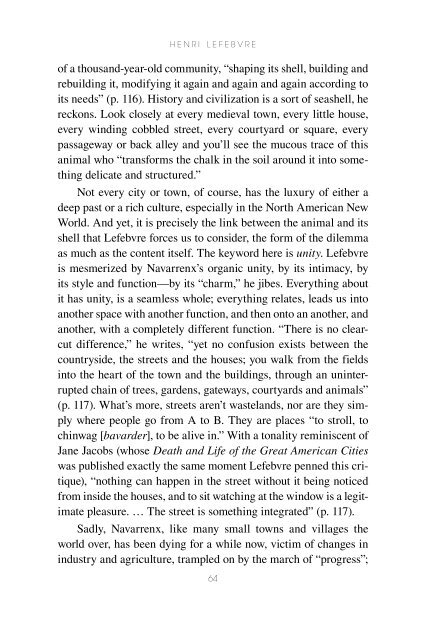Henri Lefebvre: A Critical Introduction - autonomous learning
Henri Lefebvre: A Critical Introduction - autonomous learning
Henri Lefebvre: A Critical Introduction - autonomous learning
Create successful ePaper yourself
Turn your PDF publications into a flip-book with our unique Google optimized e-Paper software.
H e n r i L e F e b v r e<br />
of a thousand-year-old community, “shaping its shell, building and<br />
rebuilding it, modifying it again and again and again according to<br />
its needs” (p. 116). History and civilization is a sort of seashell, he<br />
reckons. Look closely at every medieval town, every little house,<br />
every winding cobbled street, every courtyard or square, every<br />
passageway or back alley and you’ll see the mucous trace of this<br />
animal who “transforms the chalk in the soil around it into something<br />
delicate and structured.”<br />
Not every city or town, of course, has the luxury of either a<br />
deep past or a rich culture, especially in the North American New<br />
World. And yet, it is precisely the link between the animal and its<br />
shell that <strong>Lefebvre</strong> forces us to consider, the form of the dilemma<br />
as much as the content itself. The keyword here is unity. <strong>Lefebvre</strong><br />
is mesmerized by Navarrenx’s organic unity, by its intimacy, by<br />
its style and function—by its “charm,” he jibes. Everything about<br />
it has unity, is a seamless whole; everything relates, leads us into<br />
another space with another function, and then onto an another, and<br />
another, with a completely different function. “There is no clearcut<br />
difference,” he writes, “yet no confusion exists between the<br />
countryside, the streets and the houses; you walk from the fields<br />
into the heart of the town and the buildings, through an uninterrupted<br />
chain of trees, gardens, gateways, courtyards and animals”<br />
(p. 117). What’s more, streets aren’t wastelands, nor are they simply<br />
where people go from A to B. They are places “to stroll, to<br />
chinwag [bavarder], to be alive in.” With a tonality reminiscent of<br />
Jane Jacobs (whose Death and Life of the Great American Cities<br />
was published exactly the same moment <strong>Lefebvre</strong> penned this critique),<br />
“nothing can happen in the street without it being noticed<br />
from inside the houses, and to sit watching at the window is a legitimate<br />
pleasure. … The street is something integrated” (p. 117).<br />
Sadly, Navarrenx, like many small towns and villages the<br />
world over, has been dying for a while now, victim of changes in<br />
industry and agriculture, trampled on by the march of “progress”;<br />
64
















